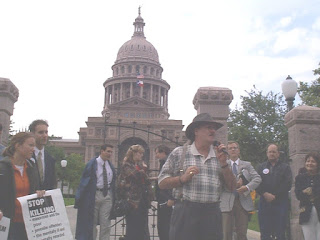 |
| Randall Dale Adams in 2001 Calling for a Moratorium on Executions in Texas |
In 2001, Randall Dale Adams testified to a committees in the Texas House and Senate and told his story of how he was wrongfully convicted and sentenced to Texas death row. His testimony helped convince the committees to vote in favor of a moratorium on executions. Later in 2001, 53 members of the Texas House voted for a moratorium on the floor of the Texas House in a bill filed by Rep Harold Dutton.
This Tuesday, the House Committee on Criminal Jurisprudence will again consider a bill for a moratorium on executions (Facebook event page). The committee members should consider the case of Randall Adams as they consider whether they should vote for a moratorium.
Watch the beginning of “The Thin Blue Line” the documentary by Errol Morris that led to the exoneration of Randall Dale Adams, who at the time the film came out was still on death row in Texas.
Watch Errol Morris – The Thin Blue Line in Educational & How-To | View More Free Videos Online at Veoh.com
Listen to some music by Phillip Glass composed for the film “The Thin Blue Line”.








I never thought I'd live to hear my voice and words stating my support for ending the Death penalty, but I can no longer support it. How can any American, specifically conservatives like me, support the killing of an innocent American by our government for no reason other than expediancy? Keep up the good work. Thank you for being open-minded before the rest of us!
My name is Kerry Max Cook. I am not here to talk about what it took for me to survive twenty-two years on death row as an innocent person. I am here to talk about a man I met while I was on Texas death row also innocent, my friend, Randall Dale Adams.
It was the summer of 1978 when I met a young Randall Dale Adams on cellblock J-21 — the original death row "wing" where those exiled under a sentence of death were assigned "Ad. Seg," or Administrative Segregation, as prison officials call it.
Death row was a lot of things, but most of all, it was a wild and crazy place, a hate-factory and an austere human repository warehousing every conceivable mental and emotional disorder known to the Diagnostic and Statistical Manual of Mental Disorders (DSM).
As an example, Randall and I would be talking and, without warning, violence erupted from somewhere around us. Once, I witnessed a quick scuffle and then heard the dull thud of a heavy body falling solidly to the concrete floor, met by a guard’s shrill screams, “FIGHT! FIGHT! FIGHT!” The body of death row inmate Edward King lay prostrate gasping his last breath with a chicken bone protruding from his chest, mortally wounded by a fellow death row inmate – – his best friend. By the time the nurses arrived, Edward King needed only the stale, dirty State-issued dingy sheet to wrap and remove him to await the Walker County coroner’s office.
Randall Dale Adams clearly didn’t belong there, despite having come, at one time, less than 72 hours away from execution. He didn’t suffer from an anti-social, schizophrenic personality disorder, indigenous to a diseased and dangerous mind gone AWOL. Randall Dale Adams was no killer.
Simply put, Randall Dale Adams was a square, an innocent American citizen who fell victim to the antics of a troubled teenager named David Ray Harris. Randall, through twist of fate, got caught in the cross hairs of an overzealous Texas prosecutor. Randall was a naive, quiet and unassuming, kind man who cared about others. Had he not agreed to give David Harris a ride that fateful night, I would not have met Randall on death row and officer Robert W. Wood would still be alive.
The last time I saw Randall was when we met in Austin and testified before the 77th Texas Legislature.
Randall’s ordeal with Texas officials and the fight to clear his name and be recognized was so grueling and intense; he left public life and moved back to his hometown of Columbus, Ohio where he died last October.
In representing Randall in this moment of grief, I think if Randall could have left you with something, it would be this:
“We rightfully legislate laws to honor victims of unspeakable crimes. You didn’t recognize me in life, and maybe you won’t recognize me in death, but I still believe in you, even though your politics sometimes prevents you from believing in me. You don’t have to remember me, but please, for the sake of those who follow after me, please remember my story….”